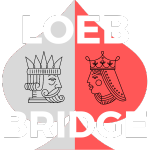After your partner opens 1NT, a responder with a long minor would like to have a way to show their long minor and describe the strength of their hand.
We recommend using a 2♠ response as a Range Asking Bid to handle hands with long clubs of any strength as well as balanced invitational hands with no 4-card major. We recommend using a 2NT response for hands with long diamonds of any strength. Here is a summary of responses and continuations. The reasons we recommend this approach are discussed at the end of this article.
The following responses to a 1NT opening bid are used to show a long minor.
| Response | Meaning |
| 2♠ | An artificial Range Asking Bid showing a balanced invitational hand with no 4-card major or a hand with long clubs of any strength. |
| 2NT | Artificial, 6+ diamonds |
Opener's response to the artificial 2NT response shows whether opener would accept a game try.
| Opener's Rebid | Meaning |
| 3♣ | Artificial, would not accept a game try |
| 3♦ | Would accept a game try |
Responder's rebid will vary depending on responder's strength and opener's rebid.
| Responder's Strength | Opener's Rebid | Responder's Rebid | Meaning |
| Weak | 3♣ | 3♦ | To play |
| 3♦ | Pass | ||
| Invitational | 3♣ | 3♦ | To Play |
| 3♦ | See discussion below | ||
| Game Forcing | 3♣ | See discussion below | |
| 3♦ |
Responder will force to game if they have a game forcing hand or had an invitational hand and opener indicated they would accept a game try.. If responder has a singleton or void in a side suit, responder will show it to help find the right game. Responder shows shortness by bidding a side suit at the 3-level.
| Responder's Rebid | Meaning |
| 3♥ | Game force with long diamonds and heart shortness |
| 3♠ | Game force with long diamonds and spade shortness |
| 3NT | Natural, to play |
| 4♣ | Game force with long diamonds and club shortness, typically a slam try |
| 4♦ | Slam try with long diamonds, typically no shortness, (32)-6-2, 2-2-6-3, or 2-2-7-2 |
| 4♥ | Roman Key Card Blackwood for diamonds |
When responder shows shortness, opener will offer 3NT as the final contract if they have responder's short suit well stopped. If 3NT isn't viable, opener bids a new suit looking for the right game. The partnership may prefer playing in a major suit if a 7 or 8 card fit is available.
Range Asking Bid
The 2♠ response to a 1NT opening bid is used to show either a hand with long clubs of any strength or an invitational hand with no 4-card major. Opener's rebids show a minimum or a maximum 1NT opener. Opener's rebid tells responder how to proceed when responder has an invitational hands (balanced invitation with no 4-card major or an invitational hand with 6+ clubs). Because opener is showing whether they have a maximum or a minimum 1NT opener, the 2♠ response is called a Range Asking Bid.
| Opener's Rebid | Meaning |
| 2NT | Artificial, showing a minimum 1NT opener |
| 3♣ | Artificial, showing a maximum 1NT opener |
Responder's rebids after opener's response to the 2♠ Range Asking Bid are similar to responder's rebids after they use an artificial 2NT response to show 6+ diamonds. See our Range Asking Bid article for details on the continuation for both balanced invitational hands, and hands with long clubs of any strength.
Why this approach is recommended over the traditional approach to 4-way transfers
The traditional way to play Minor Suit Transfers is to use a 2♠ response to 1NT as the transfer to clubs, and a 2NT response as the transfer to diamonds. This allows opener to complete the transfer when they would accept a game try, and bid the suit in between when they would not accept a game try. The problem with this approach is that it replaces the natural 2NT balanced invitation without a 4-card major. With a balanced invitational hand, responder must go through Stayman even if they don't have a 4-card major. Using Stayman when responder doesn't have a 4-card major helps the defenders with their lead and the play.
Using a 2♠ as an artificial Range Asking Bid solves this problem. As discussed above, the 2♠ Range Asking Bid is used with a balanced invitational hand with no 4-card major, and can be used with hands with 6+ clubs of any strength. You lose the ability to specifically make a game try with long clubs. Instead, you ask whether opener is a maximum or a minimum for their 1NT opening bid. The benefits of concealing opener's major suit distribution far exceed what is given up by substituting the Range Ask for opener showing whether they would accept a game try with long clubs.




